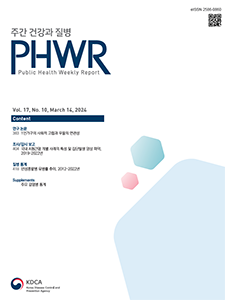Current Issue
Vol.17 No.10, March 14, 2024
-
Original Articles 2024-03-14
 1
1
 968
968
 422
422
Association between Social Isolation and Depression among Korean Living Alone
Minji Hwang, Myung Ki
Public Health Weekly Report 2024; 17(10): 383-403 https://doi.org/10.56786/PHWR.2024.17.10.1 Abstract
AbstractSingle-person households have been continuously increasing in recent times and are reporting more negative mental health outcomes. However, rather than whether single-person households are related to mental health, it is necessary to examine what characteristics of these households are associated with mental health. Therefore, this study aimed to examine the association between social isolation and depression in single-person households and explore the differences across different age groups. We employed the 2017 Community Health Survey and study population were included adults aged 19 and above living alone. Chi-square tests were conducted to compare the differences between groups with and without depression according to age groups and multiple logistic regression analysis was used to investigate the association between depression and social isolation. Socioeconomic factors, and health-related factors were controlled as confounding factors. The study found that social isolation had an association with depression in young, middle-aged, and elderly individuals, with the middle-aged group showing the strongest association. Especially, among the three variables constructing social isolation, economic activity showed the most significant association with depression for middle-aged and elderly individuals. Based on these research findings, we suggest that support for social isolation for single-person households is necessary, particularly for the middle-aged and elderly population.
-
Surveillance Reports 2024-03-14
 2
2
 492
492
 228
228
Surveillance of Hepatitis A Virus and Its Outbreak Status in the Republic of Korea, 2019 to 2022
Young Won Kim, Seung-Hoon Chae, Jin Seon Yang
Public Health Weekly Report 2024; 17(10): 404-417 https://doi.org/10.56786/PHWR.2024.17.10.2 Abstract
AbstractHepatitis A was designated as a statutory notifiable infectious disease in 2000 and has been monitored through sentinel surveillance since 2001. Following the comprehensive revision of the Infectious Diseases Prevention and Management Act in December 2009, the surveillance system was converted to a passive surveillance system in 2011. This report describes domestic hepatitis A outbreaks reported to the Integrated Disease and Health Management System from 2019 to 2022, following a large outbreak of hepatitis A in 2019. During this period, the incidence rate of hepatitis A was highest in the 40–49-year age group, followed by the 30–39-year and 20–29-year age groups. The majority of outbreaks were reported in 2019 and 2021, and the most common source locations were restaurants (28 outbreaks in 2019, 6 outbreaks in 2021) and side-dish stores (1 outbreaks in 2019, 6 outbreaks in 2021). This indicates the importance of practicing good personal hygiene and food hygiene as preventive measures against hepatitis A infection. In addition, the analysis identified salted clams imported from China as a major source of hepatitis A infection. Therefore, food safety and management systems need to be strengthened and the public should be provided with health information about hepatitis A.
-
QuickStats 2024-03-14
 0
0
 228
228
 202
202
Trends in Prevalence of Chronic Kidney Disease, 2012–2022
Public Health Weekly Report 2024; 17(10): 418-419 https://doi.org/10.56786/PHWR.2024.17.10.3

pp. 1~2097
Most Keyword
?
What is Most Keyword?
- It is the most frequently used keyword in articles in this journal for the past two years.
Most Read
-
Waterborne and Foodborne Disease Outbreaks in the Republic of Korea, 2023
Myung-Jae Hwang, So Yeon Park, Hyungjun Kim, Se Jeong Yang, Sungchan Yang, Jin Seon Yang
Public Health Weekly Report 2025;18: 17-32 https://doi.org/10.56786/PHWR.2025.18.1.2 -
Implementation Plan for the Coronavirus Disease 2019 Vaccination for the 2024–2025 Season: Recommendations of the 6th Expert Committee on Immunization Practices
Hyewook Hwang, Wookeon Lee, Seohyeon Ahn, Young-Sook Choi, Seunghyun Lewis Kwon, Dongwoo Lee, Eun Hwa Choi, SokGoo Lee
Public Health Weekly Report 2025;18: 90-102 https://doi.org/10.56786/PHWR.2025.18.2.3
Editorial Office
+82-43-719-7569





 Full Text
Full Text Cite
Cite


